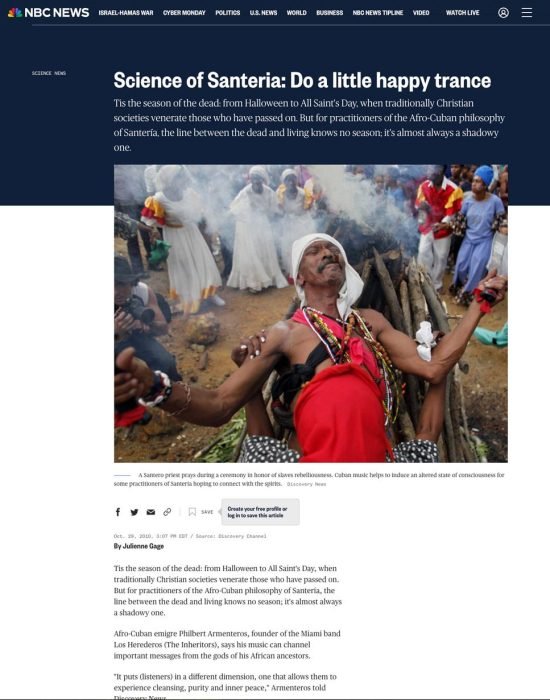INVESTIGATION DISCOVERY: Play the Haunting Game
Social scientists say that trances, a behavior common to all kinds of world religions, is biological, but also caused by learned behavior.
Art and Anthropology
By Julienne Gage
Article published in NBC NEWS by journalist By Julienne Gage
Interview conducted for the channel "Arte Mundo Latino" in 2008
This is the season of the dead: from Halloween to All Saint’s Day, when traditionally Christian societies venerate those who have passed on. But for practitioners of the Afro-Cuban philosophy of Santería, the line between the dead and living knows no season; it’s almost always a shadowy one.
Afro-Cuban emigre Philbert Armenteros, founder of the Miami band Los Herederos (The Inheritors), says his music can channel important messages from the gods of his African ancestors.
“It puts (listeners) in a different dimension, one that allows them to experience cleansing, purity and inner peace,” Armenteros told Discovery News.
Armenteros literally means a different dimension. When he drums and chants in a certain sequence, some of his listeners are lulled into a trance.
Those who practice Santería say the trance opens the doors to spirit possession, and the gods, or orishas, briefly enter the trance-induced body and use it for earthly advising.
“It does happen at concerts, but the full effect is more likely when all the right elements are present in a ceremony,” said Armenteros, explaining that more authentic trance experiences would include all the tools, such as a spiritual leader, i.e. a babalawo, or a Santero, and offerings.
Santería, also called Regla de Ocha, is a slimmed-down system of beliefs that came from the Yoruba people, in what is now Nigeria.
It is considered one of the most African of all Afro-American religious blends. Other popular examples include Haitian Vodou and Brazilian Candomblé. Each evolved within the confines of slavery in French, Spanish and Portuguese colonies.
All this scientific discussion is fine with the Santería practitioners because not everybody should fall into a trance, noted Cuban anthropologist and television producer Fermin Fleites. "Those who don't are sometimes chosen as babalawos," he said, explaining that these spiritual leaders help to interpret what a trance-induced person won't remember saying.
More content about Santeria
CONTACT US
Contact us today, our team will be happy to assist you in a period of no more than 48 hours.
Copyright © ferminfleites.com. 2020 – 2024 All Right Reserved
Designed with ❤️ in Miami by Digital Media 305
